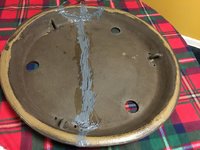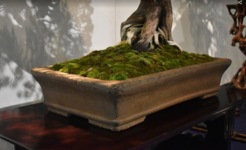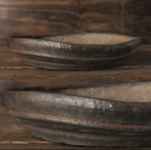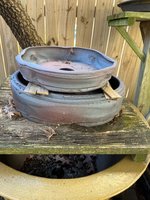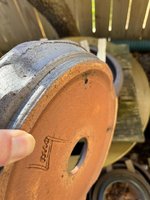You are using an out of date browser. It may not display this or other websites correctly.
You should upgrade or use an alternative browser.
You should upgrade or use an alternative browser.
Functionality of Nanban Without Feet
- Thread starter mrcasey
- Start date
KikurageOtomo
Shohin
Generally a nanban wouldn't have feet as the style emerged from repurposing things such as jar lids into bonsai pots. I can't speak to every nanban obviously, but Matsushita Hiroyuki (Better know by his BON SAI chop) adds a slight outward flare from where the drainage hole originates to ensure water isn't getting trapped.Are nanban pots supposed to have feet? Do nanaban pots without feet sometimes have drainage issues?
shinmai
Chumono
A couple of sections of Asian carry-out chopsticks work just fine.
rockm
Spuds Moyogi
Technically, nanban pots shouldn't have feet, as mentioned above, they are supposed to simulate lids for old jars that were used a long time ago. Some nanbans for bonsai have them, some don't. I have a very large Japanese nanban pot that has no feet and a smaller one that also doesn't. The larger one below has a slightly concave bottom that pushes the drainage holes up at a slight angle. I also have a few that do have feet, or a simple inconspicuous 1/4" band around the outside of the bottom that raises the bottom above the table...
Attachments
penumbra
Imperial Masterpiece

Definition of GLIB
showing little forethought or preparation : offhand; marked by ease and informality : nonchalant; lacking depth and substance : superficial… See the full definition
August
Chumono
I "make" nanban quite often from thrift store ceramics, I also prefer feet on the material that I choose but I pick up "feetless" things a lot. I'm trying out little rubber feet on them, the kind of thing that people use for the bottom of furniture. If we're talking "authentic" nanban you might not want to deface a pot in that way; the smaller, clear nubs, though, do give a pot some height with very little impact on the display overall.
Canada Bonsai
Chumono
- Messages
- 632
- Reaction score
- 2,182
I'm considering making some nanban-style pots either on the wheel or with coils, and I'm not quite sure if I should add feet.
It is worth considering here that what we typically think of as 'nanban style' pots in bonsai is only a very small fraction of what Nanban Pottery is more generally. I stole some pictures from the web to give you an idea of different types of nanban pots and pottery. In Japanese bonsai nurseries and exhibitions it is not surprising to see a bonsai in a rectangular 'nanban' pot, although they are certainly less common than the usual circular nanban style pots. All this to say that it sounds like you intend to make those circular 'nanban style' pots that we know well in bonsai, possibly with the addition of feet, and if that's the case you might want to begin your research and studies with nanban pottery more generally, if only for inspiration.
I also attached some pictures of 3 of my nanban pots (true nanban, not Japanese-made 'nanban style' pots) to show you 3 types of underside that are fairly common and the way they they meed the floor when upright--most fall within this range (their seal to the ground is by no means water-tight, and drainage has never been an issue for me).
Attachments
-
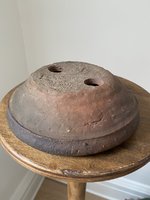 4-Canada-Bonsai-盆栽-Pot-Antique-南蛮-Nanban-4.1.jpeg174 KB · Views: 94
4-Canada-Bonsai-盆栽-Pot-Antique-南蛮-Nanban-4.1.jpeg174 KB · Views: 94 -
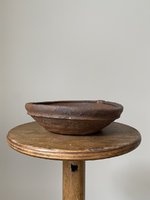 4-Canada-Bonsai-盆栽-Pot-Antique-南蛮-Nanban-4.4.jpeg88.3 KB · Views: 72
4-Canada-Bonsai-盆栽-Pot-Antique-南蛮-Nanban-4.4.jpeg88.3 KB · Views: 72 -
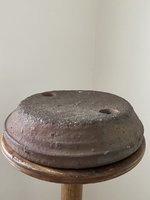 2-Canada-Bonsai-盆栽-Pot-Antique-南蛮-Nanban-1.1.jpeg128 KB · Views: 67
2-Canada-Bonsai-盆栽-Pot-Antique-南蛮-Nanban-1.1.jpeg128 KB · Views: 67 -
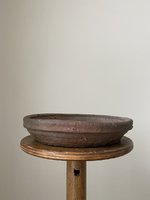 2-Canada-Bonsai-盆栽-Pot-Antique-南蛮-Nanban-1.4.jpeg76.7 KB · Views: 66
2-Canada-Bonsai-盆栽-Pot-Antique-南蛮-Nanban-1.4.jpeg76.7 KB · Views: 66 -
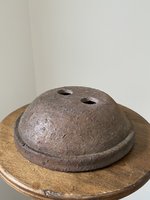 1-Canada-Bonsai-盆栽-Pot-Antique-南蛮-Nanban-1.1.jpeg182.8 KB · Views: 64
1-Canada-Bonsai-盆栽-Pot-Antique-南蛮-Nanban-1.1.jpeg182.8 KB · Views: 64 -
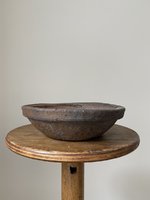 1-Canada-Bonsai-盆栽-Pot-Antique-南蛮-Nanban-1.4.jpeg93.6 KB · Views: 59
1-Canada-Bonsai-盆栽-Pot-Antique-南蛮-Nanban-1.4.jpeg93.6 KB · Views: 59 -
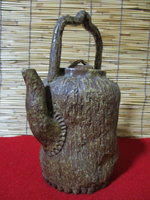 i-img480x640-1677376989jiwcpo497611.jpg65.8 KB · Views: 54
i-img480x640-1677376989jiwcpo497611.jpg65.8 KB · Views: 54 -
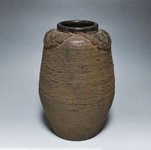 i-img563x562-1677432801q8lkmh14.jpg32.4 KB · Views: 50
i-img563x562-1677432801q8lkmh14.jpg32.4 KB · Views: 50 -
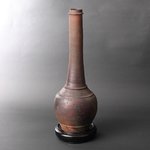 i-img800x800-1677129361ry716w332139.jpg63.7 KB · Views: 50
i-img800x800-1677129361ry716w332139.jpg63.7 KB · Views: 50 -
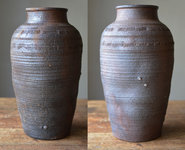 i-img924x753-1676954159cfftve288504.jpg110.6 KB · Views: 44
i-img924x753-1676954159cfftve288504.jpg110.6 KB · Views: 44 -
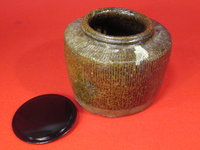 i-img1200x900-1641599465ruo7wm1117.jpg112.5 KB · Views: 43
i-img1200x900-1641599465ruo7wm1117.jpg112.5 KB · Views: 43 -
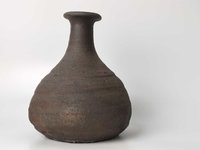 i-img1200x900-1675339477qxxbhg437087.jpg37 KB · Views: 39
i-img1200x900-1675339477qxxbhg437087.jpg37 KB · Views: 39 -
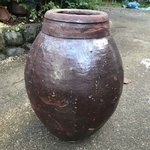 i-img1200x1200-1672702426zqnu1c16.jpg308.2 KB · Views: 51
i-img1200x1200-1672702426zqnu1c16.jpg308.2 KB · Views: 51
Holy cow! Thank you so much for this informative post!It is worth considering here that what we typically think of as 'nanban style' pots in bonsai is only a very small fraction of what Nanban Pottery is more generally. I stole some pictures from the web to give you an idea of different types of nanban pots and pottery. In Japanese bonsai nurseries and exhibitions it is not surprising to see a bonsai in a rectangular 'nanban' pot, although they are certainly less common than the usual circular nanban style pots. All this to say that it sounds like you intend to make those circular 'nanban style' pots that we know well in bonsai, possibly with the addition of feet, and if that's the case you might want to begin your research and studies with nanban pottery more generally, if only for inspiration.
I also attached some pictures of 3 of my nanban pots (true nanban, not Japanese-made 'nanban style' pots) to show you 3 types of underside that are fairly common and the way they they meed the floor when upright--most fall within this range (their seal to the ground is by no means water-tight, and drainage has never been an issue for me).
Indeed - "superficial"
Definition of GLIB
showing little forethought or preparation : offhand; marked by ease and informality : nonchalant; lacking depth and substance : superficial… See the full definitionwww.merriam-webster.com
I had no idea that nanban pots could look like this. Super interesting. By the way, I absolutely love your work.Here is a true antique nanban rectangle from this year's Kokufu
View attachment 474507
Maybe nobody cares but I find it interesting....
Southern Chinese pottery (Cantons, Chinese nanbans) are unique in bonsai pottery for being fluxed with micas instead of the normal feldspars. The micas have a much lower melting temperature, which enabled potters to fire with primitive kilns at lower temps. The look and feel of real old southern Chinese clay is unmistakable, its like cemented crumbly particles rather than a glass. These are general rules and there are exceptions.
In northern China the clays are feldspar based which pushed the development of high fire kilns and the invention of stonewares and porcelains.
So the north/south china geological reason is why bonsai pots are different in southern China.
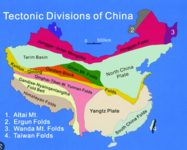
Southern Chinese pottery (Cantons, Chinese nanbans) are unique in bonsai pottery for being fluxed with micas instead of the normal feldspars. The micas have a much lower melting temperature, which enabled potters to fire with primitive kilns at lower temps. The look and feel of real old southern Chinese clay is unmistakable, its like cemented crumbly particles rather than a glass. These are general rules and there are exceptions.
In northern China the clays are feldspar based which pushed the development of high fire kilns and the invention of stonewares and porcelains.
So the north/south china geological reason is why bonsai pots are different in southern China.

chicago1980
Omono
- Messages
- 1,421
- Reaction score
- 2,719
Appreciate the material i discussion. It creates a beautiful texture and color in s Chinese pottery. I have been slowly collecting man ban for bonsai and while mental patience is needed, it is wonderful. I hope to add more shapes to my small collection .Maybe nobody cares but I find it interesting....
Southern Chinese pottery (Cantons, Chinese nanbans) are unique in bonsai pottery for being fluxed with micas instead of the normal feldspars. The micas have a much lower melting temperature, which enabled potters to fire with primitive kilns at lower temps. The look and feel of real old southern Chinese clay is unmistakable, its like cemented crumbly particles rather than a glass. These are general rules and there are exceptions.
In northern China the clays are feldspar based which pushed the development of high fire kilns and the invention of stonewares and porcelains.
So the north/south china geological reason is why bonsai pots are different in southern China.
View attachment 474521
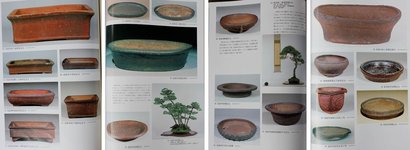
chicago1980
Omono
- Messages
- 1,421
- Reaction score
- 2,719
rockm
Spuds Moyogi
A couple of Ron Lang nanban(ish) pots. He used a 1/4" ring around the bottom of the round pot broken by three half inch spaces. That makes it looks basically like it has no feet, but is elevated inconspicuously.
The larger pot has more visible feet.
The larger pot has more visible feet.
Attachments
Last edited:
Attmos
Chumono
It sounds to me like Nanban has been mistaken for a particular look because it originated in a place that only used one style of firing... instead of the process or need for them.
They represent repurposed containers made out of necessity by people who maybe could not afford proper pottery. The fact that the historic examples all look alike has more to do with 'geography, need and accessibility' than style. So.... Nanban is more of an idea than a particular style.
This makes me wonder if repurposing modern pottery out of need (maybe a little desire too, lol), would be considered Nanban by modern growers....
They represent repurposed containers made out of necessity by people who maybe could not afford proper pottery. The fact that the historic examples all look alike has more to do with 'geography, need and accessibility' than style. So.... Nanban is more of an idea than a particular style.
This makes me wonder if repurposing modern pottery out of need (maybe a little desire too, lol), would be considered Nanban by modern growers....
Last edited:
Similar threads
- Replies
- 1
- Views
- 241
- Replies
- 0
- Views
- 246

